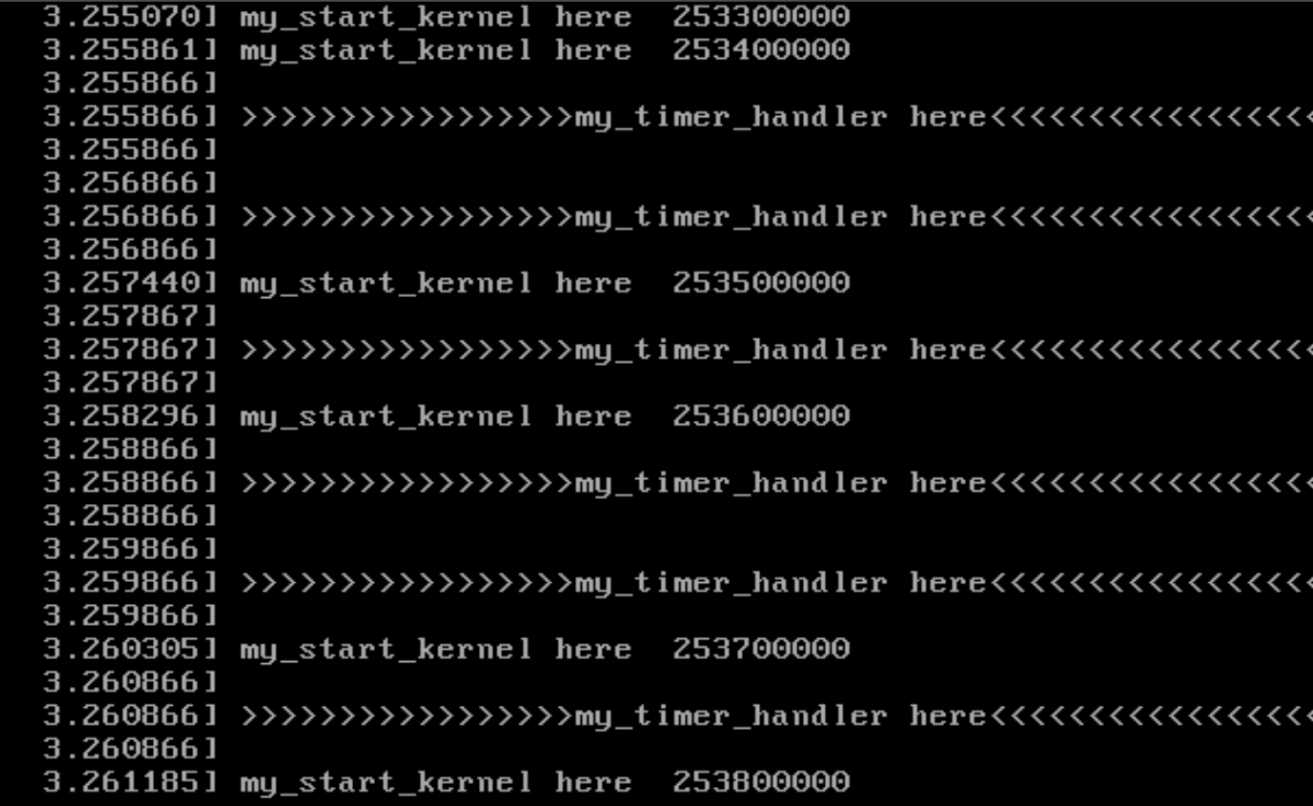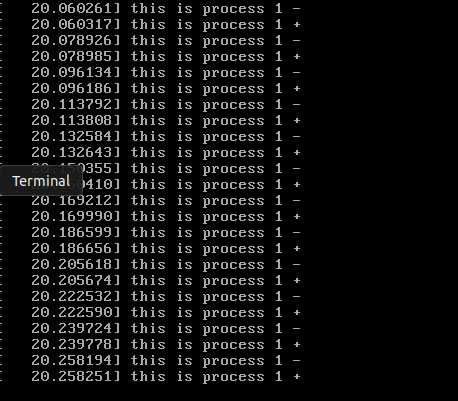标签:算法 amp call 初始化 null 循环 count return ext
一、实验步骤及过程
1.下载Linux内核并进行配置、运行:
wget https://raw.github.com/mengning/mykernel/master/mykernel-2.0_for_linux-5.4.34.patch(这一步从群里下载直接复制过来即可) sudo apt install axel axel -n 20 https://mirrors.edge.kernel.org/pub/linux/kernel/v5.x/linux-5.4.34.tar.xz xz -d linux-5.4.34.tar.xz tar -xvf linux-5.4.34.tar cd linux-5.4.34 patch -p1 < ../mykernel-2.0_for_linux-5.4.34.patch sudo apt install build-essential libncurses-dev bison flex libssl-dev libelf-dev make defconfig # Default configuration is based on ‘x86_64_defconfig‘ make -j$(nproc) sudo apt install qemu # install QEMU qemu-system-x86_64 -kernel arch/x86/boot/bzImage
2.模拟器运行结果:

看到QEMU窗?输出的内容的代码 ,有?个虚拟的CPU执?C代码的上下?环境,看到mymain.c中的代码在不停地执?。同时有?个中断处理程序的上下?环境,,能够触发myinterrupt.c中的代码。这样就通过Linux内核代码模拟实现了?个具有时钟中断和C代码执?环境的硬件平台。
打开mymain.c以及myinterrupt.c文件,可以看到:mymain.c中有一个死循环,不断输出my_start_kernel here,myinterrupt.c中则不断输出时钟中断"my_timer_handler here",根据之前qemu的运行结果,可以看出进程和时钟中断不断的交替运行
现在我们要做的就是写一个自己的进程控制块以及调度算法。
2.基于mykernel 2.0编写一个操作系统内核,参照https://github.com/mengning/mykernel 提供的范例代码
第一步:
?先在mykernel?录下增加?个 mypcb.h头?件,
定义Thread结构体,其中包括指令指针ip和堆栈指针sp。
定义结构体变量PCB用来描述进程的各个参数。
声明调度函数my_schedule.
/*定义最大进程数*/ #define MAX_TASK_NUM 4 /*定义了堆栈空间大小 */ #define KERNEL_STACK_SIZE 1024*2 /* CPU-specific state of this task 定义了一个结构体用来保存当前ip和sp */ struct Thread { unsigned long ip; unsigned long sp; }; typedef struct PCB{ int pid; /* 进程号*/ volatile long state; /* 进程状态 -1 unrunnable, 0 runnable, >0 stopped */ unsigned long stack[KERNEL_STACK_SIZE]; /* 内存堆栈大小 */ /* CPU-specific state of this task */ struct Thread thread; /* 上述结构体 */ unsigned long task_entry; /* 程序入口 */ struct PCB *next; /* 链表,将进程控制块串联起来 */ }tPCB; void my_schedule(void); /* 声明进程调度函数 */
在mymain.c中修改my_start_kernel函数
#include "mypcb.h" tPCB task[MAX_TASK_NUM]; //进程队列 tPCB * my_current_task = NULL; //当前进程 volatile int my_need_sched = 0;//进程调度标志 void my_process(void); void __init my_start_kernel(void) { int pid = 0; int i; /* 初始化0号进程 */ task[pid].pid = pid; task[pid].state = 0;/* 0号进程运行 */ task[pid].task_entry = task[pid].thread.ip = (unsigned long)my_process; task[pid].thread.sp = (unsigned long)&task[pid].stack[KERNEL_STACK_SIZE-1]; task[pid].next = &task[pid]; /*创建更多进程*/ for(i=1;i<MAX_TASK_NUM;i++) { memcpy(&task[i],&task[0],sizeof(tPCB)); task[i].pid = i; task[i].state = 0; task[i].thread.sp = (unsigned long)&task[i].stack[KERNEL_STACK_SIZE-1]; task[i].next = task[i-1].next; task[i-1].next = &task[i]; } /* start process 0 by task[0] */ pid = 0; my_current_task = &task[pid]; asm volatile( "movq %1,%%rsp\n\t" /* 将当前进程的栈顶指针sp值赋值给rsp寄存器中*/ "pushq %1\n\t" /* push rbp */ "pushq %0\n\t" /* push task[pid].thread.ip */ "ret\n\t" /* pop task[pid].thread.ip to rip */ : : "c" (task[pid].thread.ip),"d" (task[pid].thread.sp) /* input c or d mean %ecx/%edx*/ ); } void my_process(void) { int i = 0; while(1) { i++; if(i%10000000 == 0) { printk(KERN_NOTICE "this is process %d -\n",my_current_task->pid); if(my_need_sched == 1) { my_need_sched = 0; my_schedule(); } printk(KERN_NOTICE "this is process %d +\n",my_current_task->pid); } } }
修改myinterrupt.c
#include "mypcb.h" extern tPCB task[MAX_TASK_NUM]; extern tPCB * my_current_task; extern volatile int my_need_sched; volatile int time_count = 0; /* * Called by timer interrupt. */ /* void my_timer_handler(void) { pr_notice("\n>>>>>>>>>>>>>>>>>my_timer_handler here<<<<<<<<<<<<<<<<<<\n\n"); } */ void my_timer_handler(void) { if(time_count%1000 == 0 && my_need_sched != 1) { printk(KERN_NOTICE ">>>my_timer_handler here<<<\n"); my_need_sched = 1; } time_count ++ ; return; } void my_schedule(void) { tPCB * next; tPCB * prev; if(my_current_task == NULL || my_current_task->next == NULL) { return; } printk(KERN_NOTICE ">>>my_schedule<<<\n"); /* schedule */ next = my_current_task->next; prev = my_current_task; if(next->state == 0)/* -1 unrunnable, 0 runnable, >0 stopped */ { my_current_task = next; printk(KERN_NOTICE ">>>switch %d to %d<<<\n",prev->pid,next->pid); /* switch to next process */ asm volatile( "pushq %%rbp\n\t" /* save rbp of prev */ "movq %%rsp,%0\n\t" /* save rsp of prev */ "movq %2,%%rsp\n\t" /* restore rsp of next */ "movq $1f,%1\n\t" /* save rip of prev */ "pushq %3\n\t" "ret\n\t" /* restore rip of next */ "1:\t" /* next process start here */ "popq %%rbp\n\t" : "=m" (prev->thread.sp),"=m" (prev->thread.ip) : "m" (next->thread.sp),"m" (next->thread.ip) ); } return; }
创建一个0号的进程,然后用一个for循环创建了3个进程,并用链表连起来。
这段代码还对寄存器EIP,EBP,ESP进行初始化,先将堆栈指针sp赋给了ESP寄存器,然后将堆栈指针sp内容压栈,之后将指令指针ip的内容也压栈,下一条指令是ret,它是将当前栈中ESP所指的内容出栈到EIP中,当前ESP所指的内容就是前一条指令压栈进去的ip的值,现在使得EIP寄存器的内容就是进程0的入口地址(ip内容),从而使得进程0能够被执行。
运行结果:

标签:算法 amp call 初始化 null 循环 count return ext
原文地址:https://www.cnblogs.com/yizhan-eventually/p/13192554.html